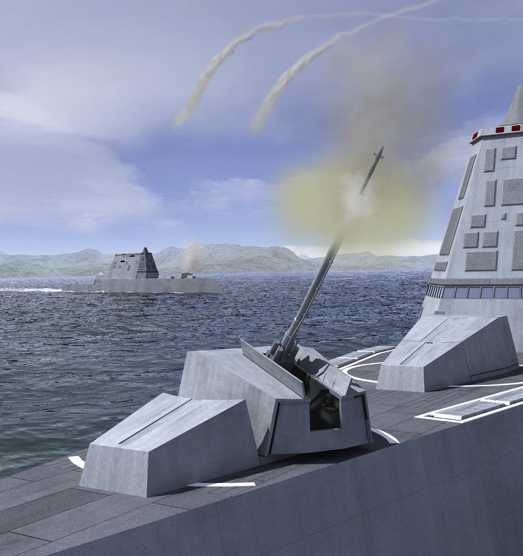|
As a vertical gun system, this weapon could have used only guided munitions. With the more traditional design, both conventional as well as guided munitions may now be used. The concept of this weapon is thus similar to that of the 5"/62 (12.7 cm) Mark 45 Mod 4 program. Ballistic round development for AGS has been reportedly postponed or cancelled and none of the existing US Army or NATO 155 mm projectiles can be adapted for use in AGS. The design of this weapon will include a fully automated ammunition magazine to reduce the crew size and to maximize the ammunition capacity. Ammunition for this weapon will use a separate propellant canister, which will be used for both conventional and guided munitions. Proposed projectiles include guided land and surface attack munitions as well as ballistic projectiles using course correcting fuzes (CCF). Planned CEP accuracy for guided weapons is 20 to 50 m (22 to 55 yards). An AGS firing Long Range Land Attack Projectiles (LRLAP) at 12 rounds per minute was considered to be equivalent to one 155 mm artillery battery (6 guns) firing at 2 rounds per gun per minute. However, as part of a weight reduction program, BAE in 2005 derated the ROF of the AGS down to 10 rounds per minute. In October 2001 the first prototype was successfully proof-tested, firing eleven test projectiles at pressures ranging from 50% below normal to 50% above normal. In April 2003 Lockheed-Martin was selected over Raytheon to continue development of the Long Range Land Attack Projectile (LRLAP). This phase includes the manufacturing of 15 rounds to conduct flight tests and support the AGS Critical Design Review (CDW). A September 2004 GAO report stated: "While development of the advanced gun system is proceeding as planned and has even overcome early challenges in design and development, the current plans do not include fully demonstrating the maturity of the subsystem. Land based testing of the gun system, including the automated mount and magazine, is planned for the summer of 2005 and flight tests for the munition are set to complete in September of 2005. However, the two technologies will not be tested together until after ship installation. Program officials cited lack of adequate test facilities as the reason for the separate tests." In June 2005, a Northrop Grumman press release stated that "The LRLAP Guided Flight-four (GF-04) gun test marked the longest successful guided-projectile test in history. The LRLAP, fired at the San Nicolas Island test facility at the Naval Air Warfare Center, Weapons Division, Pt. Mugu, Calif., (NAWC-WD), flew a guided trajectory to an impact location more than 59 nautical miles down range." In June 2005 United Defense won a $376 million contract from the Naval Sea Systems Command for the continuation of design, development and test of the AGS, including the fully automated gun, magazine and the Long Range Land Attack Projectile (LRLAP), for use aboard the Navy's new DD(X) Destroyer. In July 2005, BAE Systems, who purchased United Defense, awarded Lockheed Martin a $120 million contract for for further development and testing of LRLAP. This cost-plus-award-fee contract covers additional development and tests during 2006-2008 and support to AGS qualification testing during 2009-2010. More than 100 projectiles will be delivered and tested under this contract. Full-rate production is expected to begin in 2011. A 21 September 2005 US Naval Sea Systems Command press release regarding a rate of fire test for AGS conducted on 31 August 2005 stated: "The test successfully demonstrated a sustained maximum rate of fire of at least ten rounds per minute in eight round bursts, and unloaded eight complete rounds from a pallet in 45 seconds or less. The event also tested a sustained firing capability and reliability by demonstrating the AGS Engineering Development Model gun and magazine are capable of unloading several pallets of ammunition." A U.S. Department of Defense press release dated 7 April 2006 announced that "the first DD(X) destroyer will be designated DDG 1000. As the lead ship in the class, it will also be named in honor of former Chief of Naval Operations (CNO) Adm. Elmo R. "Bud" Zumwalt, Jr." A BAE press release dated 26 April 2007 announced that Naval Sea Systems Command had added a $108.9 million cost-plus-award-fee modification to the previously awarded contract for completion of the design, development and integration of the Advanced Gun System (AGS) for DDG-1000. Perhaps unsurprisingly given the high cost overruns associated with this project, Defense News reported in a 22 July 2008 article that the USN appears ready to halt the DDG-1000 program at only two ships rather than seven - which was already down from the originally planned 32 ships - and to instead build eight to eleven up-rated Arleigh Burke DDG-51 class destroyers, construction of which had been slated to end in 2012. The same article states that the Navy is investigating using the SPY-3 radar system and the AGS gun on these new DDG-51 destroyers. In 2012 BAE proposed a light-weight version of the AGS for use on the DDG-51 Flight III class that had a simpler mounting. Called the "155mm Advanced Gun System-Lite (AGS-L)," this mounting would have limited ammunition compared to the 5"/62 (12.7 cm) Mark 45 Mod 4 or the standard AGS. Unless otherwise noted, the data that follows is for the standard AGS gun and mounting. |

Artist's conception of two AGS mounts on
DD (X)
|
| .
|